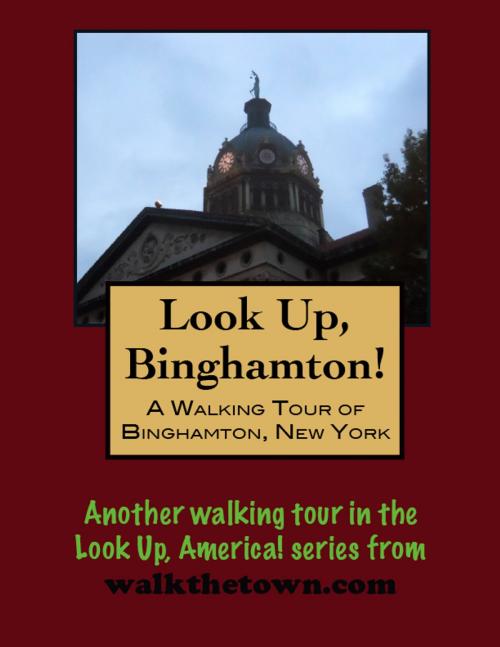Look Up, Binghamton! A Walking Tour of Binghamton, New York
Nonfiction, Travel, United States, History, Americas| Author: | Doug Gelbert | ISBN: | 9781452384719 |
| Publisher: | Doug Gelbert | Publication: | November 11, 2010 |
| Imprint: | Smashwords Edition | Language: | English |
| Author: | Doug Gelbert |
| ISBN: | 9781452384719 |
| Publisher: | Doug Gelbert |
| Publication: | November 11, 2010 |
| Imprint: | Smashwords Edition |
| Language: | English |
There is no better way to see America than on foot. And there is no better way to appreciate what you are looking at than with a walking tour. Whether you are preparing for a road trip or just out to look at your own town in a new way, a downloadable walking tour is ready to explore when you are.
Each walking tour describes historical and architectural landmarks and provides pictures to help out when those pesky street addresses are missing. Every tour also includes a quick primer on identifying architectural styles seen on American streets.
The two most important names in Binghamton’s early history were William Bingham and Joshua Whitney. Bingham was a wealthy Philadelphia banker who after 1792 owned the land around the confluence of the Susquehanna and Chenango rivers. He dreamed of developing a busy trading village at such a favored location and to that end hired Whitney to be his land agent. Whitney worked tirelessly to build the new settlement; he laid out street plans, he constructed the first courthouse and erected the first bridge over the Susquehanna River. Bingham died in 1804 and never got around to actually visiting the area but his name was on the deed so the town was named for him once the original name of Chenango Point was wiped away. Nothing was named for Whitney who did most of the work building the place.
Already a busy crossroads town, Binghamton’s stature as a transportation hub was enhanced further in 1837 with the opening of the Chenango Canal that linked the town to the Erie Canal. The first great business to appear was cigar-making and Binghamton became the nation’s second largest supplier of cigars, behind only New York City. More than 5,000 workers were employed rolling over 100 million cigars a year. But there were other products as well; by the end of the 1800s over 200 hundred different types of products were being shipped from Binghamton.
About that time, in 1890, a leather supplier from Dedham, Massachusetts arrived in Binghamton and bought into a distressed Lester Brothers Shoe Company. Henry B. Endicott sold enough boots to turn a small profit, but he was dissatisfied with his manager. A foreman from the Lester days applied for the job and stated confidently that he would work for nothing for one year if he did not show results. With George F. Johnson handling the manufacturing and Endicott the finances, the firm of Endicott-Johnson became the largest shoe company in the world, employing 20,000 workers in the area. By the time George Johnson stepped down in 1930, Endicott-Johnson had sold its one billionth shoe.
Binghamton’s population peaked in the 1950s with over 80,000 and about that time the city energetically embraced the urban renewal craze transforming America. The result is that the city spent the last half of the 20th century losing both people and buildings. To see what remains our walking tour will explore both sides of the Chenango River; the West Side where wealthy Binghamtonians constructed lavish mansions and the east bank where business and government have clustered for over 200 years and we will begin our double loop, figure-eight exploration where all city roads lead...
There is no better way to see America than on foot. And there is no better way to appreciate what you are looking at than with a walking tour. Whether you are preparing for a road trip or just out to look at your own town in a new way, a downloadable walking tour is ready to explore when you are.
Each walking tour describes historical and architectural landmarks and provides pictures to help out when those pesky street addresses are missing. Every tour also includes a quick primer on identifying architectural styles seen on American streets.
The two most important names in Binghamton’s early history were William Bingham and Joshua Whitney. Bingham was a wealthy Philadelphia banker who after 1792 owned the land around the confluence of the Susquehanna and Chenango rivers. He dreamed of developing a busy trading village at such a favored location and to that end hired Whitney to be his land agent. Whitney worked tirelessly to build the new settlement; he laid out street plans, he constructed the first courthouse and erected the first bridge over the Susquehanna River. Bingham died in 1804 and never got around to actually visiting the area but his name was on the deed so the town was named for him once the original name of Chenango Point was wiped away. Nothing was named for Whitney who did most of the work building the place.
Already a busy crossroads town, Binghamton’s stature as a transportation hub was enhanced further in 1837 with the opening of the Chenango Canal that linked the town to the Erie Canal. The first great business to appear was cigar-making and Binghamton became the nation’s second largest supplier of cigars, behind only New York City. More than 5,000 workers were employed rolling over 100 million cigars a year. But there were other products as well; by the end of the 1800s over 200 hundred different types of products were being shipped from Binghamton.
About that time, in 1890, a leather supplier from Dedham, Massachusetts arrived in Binghamton and bought into a distressed Lester Brothers Shoe Company. Henry B. Endicott sold enough boots to turn a small profit, but he was dissatisfied with his manager. A foreman from the Lester days applied for the job and stated confidently that he would work for nothing for one year if he did not show results. With George F. Johnson handling the manufacturing and Endicott the finances, the firm of Endicott-Johnson became the largest shoe company in the world, employing 20,000 workers in the area. By the time George Johnson stepped down in 1930, Endicott-Johnson had sold its one billionth shoe.
Binghamton’s population peaked in the 1950s with over 80,000 and about that time the city energetically embraced the urban renewal craze transforming America. The result is that the city spent the last half of the 20th century losing both people and buildings. To see what remains our walking tour will explore both sides of the Chenango River; the West Side where wealthy Binghamtonians constructed lavish mansions and the east bank where business and government have clustered for over 200 years and we will begin our double loop, figure-eight exploration where all city roads lead...















